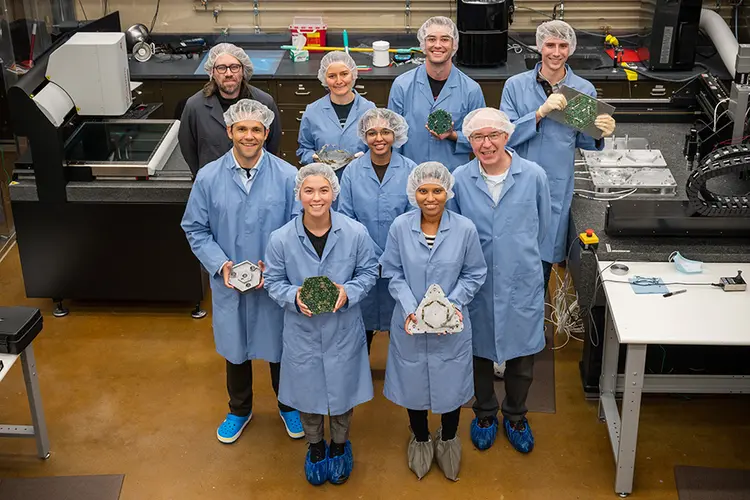
Isoprene From Rainforests Drives New Particle Formation
Media Inquiries
Changes in atmospheric particles since preindustrial times have masked some of the warming caused by rising levels of carbon dioxide. Atmospheric particles cool the climate by directly reflecting sunlight and by making clouds more reflective; they are also deadly pollution.
Fifteen years ago, it was thought that sulfuric acid drove almost all particle formation. The CERN Cosmics Leaving Outdoor Droplets (CLOUD) experiment is filling in information that has been underrepresented in global climate models in order to understand how things will change as sulfuric acid concentrations decrease.
Sulfuric acid is formed in the atmosphere by the oxidation of sulfur dioxide, which is released when fuel burns. To reduce air pollution, high sulfur fuels like coal have been systematically banned around the world. Scientists expected that reducing sulfuric acid would reduce the number of particles.
As part of the CLOUD experiment, researchers from Carnegie Mellon University are helping to identify other molecules and processes that contribute to particle formation.
"We used to think that as we pulled out sulfur, all the climate change hiding behind that air pollution would be revealed. Just how much is not so obvious anymore," said Neil Donahue(opens in new window). "The pollution kills upwards of 7 million people every year, and we need to get rid of it; just how we go about doing that may also matter for climate."
CLOUD findings published in Nature(opens in new window)(opens in new window) show that the compound isoprene is driving particle formation in large regions of the tropical upper atmosphere. Prior to this work, scientists thought that isoprene was incapable of forming new particles in the atmosphere.
Isoprene is the most abundant nonmethane hydrocarbon emitted into the atmosphere. It is released by trees, and the Amazon has some of the highest isoprene concentrations and the lowest sulfur dioxide concentrations over land. An accompanying paper reports aircraft observations made over the Amazon at the same time as the CLOUD experiments.
CLOUD combines fundamental experiments and modeling to study how particles form and grow from reactive gasses under atmospheric conditions. In the very cold and exceptionally clean conditions of the CLOUD chamber at CERN, researchers can set up the chemical mechanisms that generate gasses and then watch the gasses produce particles.
In new experiments, researchers studied particle formation from the oxidation of isoprene at -30 and -50 degrees Celsius. Donahue, Thomas Lord University Professor of Chemistry, Chemical engineering, and Engineering and Public policy at Carnegie Mellon and a member of the CLOUD consortium, verified the observations by direct particle-phase measurements.
The Donahue group used a mass spectrometer they developed, called FIGAERO CIMS (Filter Inlet for Gas and AEROsols Chemical Ionization Mass Spectrometer), to measure the material in the particles produced when isoprene is oxidized. Their measurements showed that changing the chemical conditions in the CLOUD chamber changes the composition of the particles. "We're able to isolate that chemistry in the experiment, show that indeed it does happen, and begin to piece apart the molecular detail of that chemistry that contributes to the particles forming," Donahue said.
Isoprene from forests is efficiently transported at night by deep convective clouds into the upper troposphere. During daylight, the isoprene that has accumulated overnight, together with daytime-convected isoprene, reacts with hydroxyl radicals and NOx from lightning to produce oxygenated isoprene organic molecules. These combine with trace amounts of acids to produce high particle concentrations at temperatures below −30 °C. The newly formed particles grow rapidly over several hours and days while following the descending air masses. This mechanism may provide an extensive source of cloud condensation nuclei for shallow continental and marine clouds, which influence Earth’s radiative balance. Courtesy of CERN
Collaborators with CMU ties
From the Donahue group, Jenna DeVivo, Nirvan Bhattacharyya, and Brandon Lopez contributed to the research. Authors Ilona Riipinen and Xu-Cheng He, also members of the CLOUD consortium, were previously postdoctoral fellows at Carnegie Mellon.
Particle formation in the atmosphere is most important in clean conditions and at cold temperatures, which are precisely the circumstances in which the process of isoprene oxidation is active. "The chemical mechanism involved here should work better at cold temperatures than the series of chemical reactions we thought were going on before," said Hamish Gordon(opens in new window).
The CLOUD findings show that isoprene from forests represents a major source of biogenic particles that is currently missing in climate models.
Gordon, assistant professor of chemical engineering at Carnegie Mellon and a member of the CLOUD consortium, leads the type of atmospheric modeling that is needed to determine the significance of the study. Particle formation mechanisms, like the new isoprene oxidation process, make a difference in estimates of how atmospheric particles have changed over the industrial period.
Earlier research from Gordon determined the potential atmospheric significance of particle formation without sulfuric acid.(opens in new window)(opens in new window) Although changing the rate of particle formation in the atmosphere makes only small differences, Gordon showed that introducing a new mechanism can make a big difference. Forming particles where no particles were forming before can change the quantitative estimates of the balance of radiation entering, reflected, absorbed and emitted by the Earth.
The preindustrial environment forms the baseline for how global climate models calculate the environmental change caused by people. The CLOUD findings imply that particles made as a result of living organisms in nature were more abundant in the preindustrial atmosphere than previously thought. They also imply that the biosphere may be able to partially buffer the reduction of particles, and the associated warming, as sulfur dioxide levels continue to fall with emissions controls.



